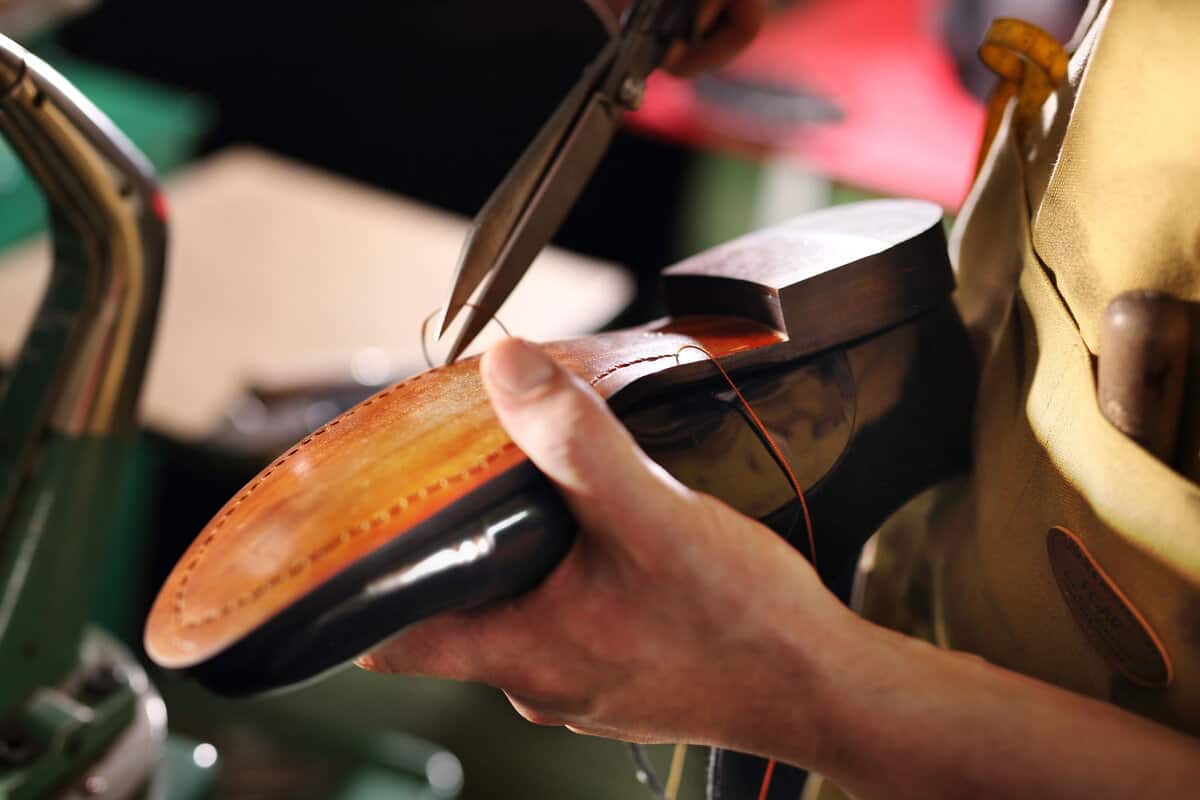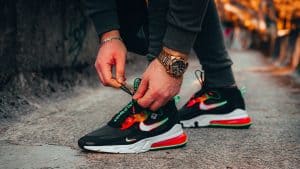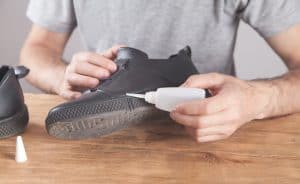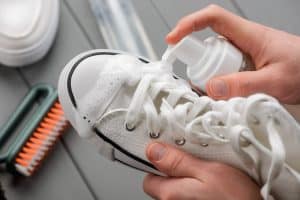When embarking on a DIY shoe repair journey, the glue you choose is crucial, and it's not the same as the ones used for typical home crafts or projects.
Cobblers have long relied on strong, professional-grade glues to ensure shoes are not only fixed but restored to their original durability and function.
A common choice among shoe repair professionals is contact cement due to its remarkable bonding versatility.

This article may include affiliate links and elements that were carefully created by our team using advanced ai to help you envision the best style advice.
Rubber cement is often the go-to adhesive in scenarios where a sole replacement is needed, providing a robust yet flexible bond that stands up to daily wear and tear.
The right glue is essential for maintaining your footwear's longevity and aesthetic appeal, even in DIY repair scenarios.
It's about picking a glue that's up to the task, ensuring your shoes are ready for many more walks and runs.
Continue reading to explore the various glues that can aid your DIY shoe repair and how to use them effectively.
What Glue Do Cobblers Use?
Cobblers typically use contact cement, rubber cement, and epoxy and acrylic adhesives. Each of these glues serves a specific purpose when bonding different materials.
Contact Cement
Contact cement is a favored adhesive in the cobbling industry due to its strong bonding prowess.
It works by adhering to itself, meaning both surfaces to be joined are coated with the glue, allowed to dry, and then pressed together.
This property makes it a reliable choice for bonding different materials, which is often required in shoe repair.
It's ideal for tasks such as reattaching soles or mending separated seams.
Rubber Cement
Rubber cement is another staple in a cobbler's toolkit.
Known for its flexibility post-adhesion, it's excellent for repairs that demand a bit of stretch, like mending soles or working with leather materials.
Its elastic nature ensures the bond remains intact even when the material is flexed, making it a suitable choice for areas of the shoe that bend with each step.
Epoxy and Acrylic Adhesive
Epoxy and acrylic adhesives are known for their strong bonding and durability. These adhesives cure to a hard, strong bond, making them ideal for repairs that require a rigid fix.
They can be particularly useful for mending broken heels, reattaching sole sections, or affixing accessories and embellishments to footwear.
Top Glue Recommendations from Cobblers
Below, we'll share some of the best glue options cobblers recommend for shoe repair and maintenance.
We've browsed customer feedback from third-party marketplaces for unbiased opinions and delved into forums to gather a well-rounded view of each adhesive's performance and reliability.
Barge Cement
Barge Leather Cement is a popular adhesive in the cobbling and leathercraft community. It is well-regarded for its bonding ability, especially when adhering leather to leather.
Users commend its performance, highlighting the need to opt for Barge's All Purpose Cement can for specifically leather tasks.
Some mention it as a go-to glue for various leather projects, with a good holding capacity, though the smell is reported to be quite strong.
Weldwood Contact Cement
Offering a blend of accessibility and affordability, Weldwood Contact Cement garners appreciation among DIY repairers.
The Gel formula of Weldwood is particularly praised for its ease of control during application and its solid hold.
However, few mentioned it did not hold well on certain materials like EVA foam. It's a more budget-friendly option but may require extra effort for optimal bonding.
Shoe Goo
Shoe Goo is marketed as a repair adhesive for worn-out soles and damaged shoes.
Users praise it for its capability to prolong the life of shoes, especially in preventing wear in certain areas.
However, others criticize it for peeling off quickly, suggesting it might be more suitable for temporary repairs or minor fixes.
Its strong odor is also something to consider while using it.
E6000 237032 Adhesive
Mixed reviews accompany the E6000 adhesive, with some users appreciating its flexibility post-curing, which can be beneficial in applications requiring a bit of movement.
However, some users report a lack of strength in the bond it creates, comparing it to a stronger version of Elmer's glue, which can be a concern for critical bonding tasks.
It may work for smaller, less demanding repair jobs but might fall short in more rigorous applications.
Loctite Super Glue ULTRA Gel
Loctite Super Glue ULTRA Gel is noted for its strong bond and ease of application.
According to users, it's quite viscous, allowing for controlled application, and dries clear, which is a plus for aesthetic repairs.
It's also mentioned to have a strong bond, but caution is advised to avoid skin contact due to its strength.
This adhesive caters to those looking for a robust and reliable bond with added control during application.
Liquid Nails "Fuze It"
Liquid Nails "Fuze It" finds its way into the world of shoe repair as an affordable and effective solution.
Users have recommended it for shoe sole repair, particularly for those seeking a budget-friendly adhesive with reliable bonding capabilities.
It has shown promise in firmly reattaching shoe soles, ensuring they withstand the daily wear and tear that footwear endures.
It's a versatile adhesive that can be used on almost any material, including leather, rubber, and fabric.
If you want to restore your favorite shoes or mend worn-out soles, "Fuze It" emerges as an affordable and effective adhesive worth considering.
As you've explored this article, you might wonder: Can Gorilla Glue fix shoes? Click here to find out!
Factors Influencing the Choice of Glue
When choosing the right glue for your DIY shoe repair project, several key factors come into play.
Your selection hinges on considerations that ensure the adhesive aligns perfectly with the task at hand, ensuring a lasting and reliable fix.
Here are the primary factors influencing the choice of glue:
Material of the Shoe
The material of your shoe plays a pivotal role in determining the ideal adhesive. For leather shoes, contact cement or rubber cement is preferred.
Conversely, for shoes made from rubber or fabric, Epoxy, and Acrylic Adhesive may be more appropriate.
Type of Repair
Another factor to consider is the type of shoe repair a cobbler needs to perform.
If you're reattaching a sole that experiences constant flexing and bending, you'll want an adhesive to accommodate the shoe's movement.
Epoxy-based adhesives may be preferred for structural repairs or bonding heavy components due to their durability and strength.
How to Effective Apply Glue During Repairs
When working with the glue that cobblers use, it's important to understand the proper application techniques.
Let's examine the key steps for effective glue application during repairs.
Step 1: Prepare Surfaces
First, ensure both surfaces you'll be bonding are clean and dry. This will help the glue adhere more effectively.
It's also essential to apply the contact cement evenly on both surfaces. You can use a brush, roller, or even a small piece of cloth for this.
Step 2: Wait for Tackiness
Once the glue is applied, wait for it to become tacky. The waiting time may vary depending on the specific adhesive, but generally, it takes around 15-20 minutes.
Step 3: Bond Surfaces
Once the glue reaches the correct level of tackiness, firmly press the two surfaces together. You'll want to apply pressure evenly across the entire bonding area.
📌 Newbie tip: a pinch roller or a simple hand pressure might do the trick!
Don't forget to clean any excess glue that might squeeze out from the edges.
As you refine your glue application technique, consider expanding your shoe repair knowledge. Explore How To Stretch Plastic Shoes for additional techniques.
Safety Considerations
Working with adhesive in shoe repair requires diligence to ensure not only the effectiveness of the repair but also your safety.
Here are important safety considerations to keep in mind:
- Adequate ventilation is essential when working with certain glues, especially those with strong fumes.
- Always wear safety goggles or protective eyewear to shield your eyes from accidental splashes or drips of glue.
- Adhesives can be harsh on the skin. To prevent skin contact, wear gloves when handling glue.
- Some adhesives are flammable. Ensure no open flames or ignition sources are nearby when working with such bonds.
- Keep adhesives out of the reach of children and pets. Some glues are toxic if ingested, and accidental consumption can be dangerous.
- Dispose of adhesive containers and waste materials responsibly. Follow local regulations for hazardous waste disposal to minimize environmental impact.
Final Thoughts
Selecting the suitable glue for shoe repair ensures a long-lasting bond.
Cobblers often use strong adhesives like contact cement, rubber cement, and epoxy due to their versatility and durability.
These powerful adhesives help maintain the integrity of your shoes for years to come, making them a reliable choice.
By using the right adhesive for shoe repair, you'll be one step closer to maintaining your favorite pair's longevity, comfort, and visual appeal. Happy glue hunting!









